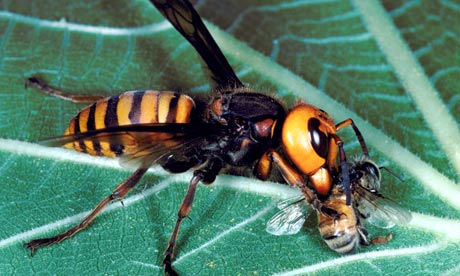
Not even chicken wings will be available for football games by 2040. Boiled beetles? More likely!
It doesn't really take an astrologer or fortune teller to forecast the primary protein on the menu by 2040. It will most assuredly be insects. All the signs point to that, in particular that with the ramping up of global warming water will become even scarcer (especially combined with the frack craze) and so water-intensive meats like beef will be literally "off the table" - except maybe for the richest.
Fish eaters will fare no better. As the March, 2014 issue of National Geographic noted, p. 74:
"The oceans are dying. The collapse of fisheries marks the decline, a steady funeral drumbeat: cod in the Maritime Provinces of Canada, anchovies off Peru. salmon off the Pacific Northwest, Patagonian toothfish in Antarctic waters, sharks in all the oceans. Bluefin tuna are among the most overfished species on Earth. The stock that spawns on the western side of the Atlantic has been reduced by 64 percent since 1970."
Some scientists go so far to predict only jellyfish will be in the oceans by 2040 on account of acidification. This means unless people living at the time (another reason not to live to 100 for many of us) fancy jellyfish they had better look for other protein sources.
What might these be? Well, insects! They are in abundance on this planet and provide an excellent protein source. Here are some facts dredged up from the September, 2014 issue of National Geographic:
- More than one fourth of the world's population (2 billion) already incorporates insects into diets
- The number of known edible insect species now totals 2,000
- Crickets are 12 times more efficient than cattle at providing nutritional (protein ) value.
- Nearly 80 % of cricket body mass is consumable compared to barely 50 % for salmon and 40 % for cattle. You get more 'bang for the buck'!
Some may be aghast, but insects properly prepared, e.g. fried crickets with some tabasco or hot pepper sauce, actually taste damned good! Apart from that, insects are already being used in a number of products, including certain medicines, cosmetics (lipstick) and to flavor alcohol.
In reality, much of the problem with eating bugs is in people's heads, the so-called 'ewwwww' or 'yuck' factor. But there are practical ways to get around that, and the sooner we train our grand kids - since they will be the ones having to either gobble bugs or become Vegans, the better. Arnold van Huis, of Wangeningen University (Netherlands), quoted in the NG issue insists the best way to do this is to "conceal the insects form". So, for example, say you are given this giant hornet:

What would you do to prepare maybe 10 of them for a casserole? Well, van Huis suggests numero uno is to process them "into pastes or powders". This then can be added toward the end of say, your macaroni and cheese casserole. By the time the dish is presented to you, you won't even know it unless some killjoy lets the bug out of the bag.
Also noted in the NG piece, "bug flours" - that are part flour and part ground insect, will "be on the market soon".
This is all good, because it gives us more time to prep our future generations for the main (and likely only widespread) source of protein they will be able to access. If we can get OUR kids used to eating them now, there will be fewer problems in getting their kids to put them on their platters by 2040.
And lastly, don't knock fried crickets until you've tried them!
No comments:
Post a Comment